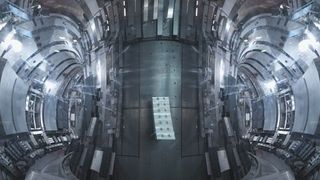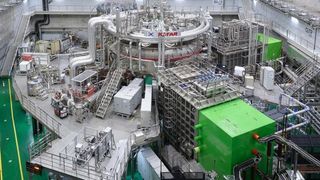Nuclear fusion reactor in South Korea runs at 100 million degrees C for a record-breaking 48 seconds
The experimental fusion reactor sustained temperatures of 180 million degrees Fahrenheit for a record-breaking 48 seconds.

South Korea's "artificial sun" has set a new fusion record after superheating a plasma loop to 180 million degrees Fahrenheit (100 million degrees Celsius) for 48 seconds, scientists have announced.
The Korea Superconducting Tokamak Advanced Research (KSTAR) reactor broke the previous world record of 31 seconds, which was set by the same reactor in 2021.The breakthrough is a small but impressive step on the long road to a source of near-unlimited clean energy.
Scientists have been trying to harness the power of nuclear fusion — the process by which stars burn — for more than 70 years. By fusing hydrogen atoms to make helium under extremely high pressures and temperatures, so-called main-sequence stars convert matter into light and heat, generating enormous amounts of energy without producing greenhouse gases or long-lasting radioactive waste.
Related: We've been 'close' to achieving fusion power for 50 years. When will it actually happen?
But replicating the conditions found inside the hearts of stars is no simple task. The most common design for fusion reactors — the tokamak — works by superheating plasma (one of the four states of matter, consisting of positive ions and negatively charged free electrons) and trapping it inside a donut-shaped reactor chamber with powerful magnetic fields.
Keeping the turbulent and superheated coils of plasma in place long enough for nuclear fusion to happen, however, has been a painstaking process. Soviet scientist Natan Yavlinsky designed the first tokamak in 1958, but no one has ever managed to create a reactor that is able to put out more energy than it takes in.
One of the main stumbling blocks has been how to handle a plasma that's hot enough to fuse. Fusion reactors require very high temperatures — many times hotter than the sun — because they have to operate at much lower pressures than where fusion naturally takes place inside the cores of stars. The core of the actual sun, for example, reaches temperatures of around 27 million F (15 million C) but has pressures roughly equal to 340 billion times the air pressure at sea level on Earth.
Get the Space.com Newsletter
Breaking space news, the latest updates on rocket launches, skywatching events and more!

Cooking plasma to these temperatures is the relatively easy part, but finding a way to corral it so that it doesn't burn through the reactor without also ruining the fusion process is technically tricky. This is usually done either with lasers or magnetic fields.
To extend their plasma's burning time from the previous record-breaking run, the scientists tweaked aspects of their reactor's design, including replacing carbon with tungsten to improve the efficiency of the tokamak’s "divertors," which extract heat and ash from the reactor.
"Despite being the first experiment run in the environment of the new tungsten divertors, thorough hardware testing and campaign preparation enabled us to achieve results surpassing those of previous KSTAR records in a short period," Si-Woo Yoon, the director of the KSTAR Research Center, said in a statement.
KSTAR scientists are aiming to push the reactor to sustain temperatures of 180 million F for 300 seconds by 2026.
The record joins others made by competing fusion reactors around the world, including one by the U.S. government-funded National Ignition Facility (NIF), which sparked headlines after the reactor core briefly put out more energy than was put into it.
Join our Space Forums to keep talking space on the latest missions, night sky and more! And if you have a news tip, correction or comment, let us know at: community@space.com.

Ben Turner is a U.K. based staff writer at Live Science. He covers physics and astronomy, among other topics like weird animals and climate change. He graduated from University College London with a degree in particle physics before training as a journalist. When he's not writing, Ben enjoys reading literature, playing the guitar and embarrassing himself with chess.
-
billslugg In 3 years they went from 31 seconds to 48 seconds at 100 million degrees C. They hope to achieve 300 seconds at 180 million degrees C within the next two years. Need to pick up the pace.Reply -
Roko Reply
Thing is Key, when Hydrogen is consumed and in the Core Star......Helium start to Fuse in Diamond (Iron&Oxigen under pressure)...."Usually", what We dont know, when happends... Such Stars can expands in diameter of cca Asteroid Belt with "Low " surface temperature (consuming first 3 Planet).... Also, is situation, what We dont know, is That Star - after Consumed Everything,,,, will going into the Black Hole or Supernova.....Admin said:The experimental fusion reactor sustained temperatures of 180 million degrees Fahrenheit for a record-breaking 48 seconds.
Nuclear fusion reactor in South Korea runs at 100 million degrees C for a record-breaking 48 seconds : Read more -
Redderek Reply
Look how long it took to go from general research to now at 48 seconds. Time will tell how things go in the future. I envisioned back in '88 that the best method for a reactor would be in space; less energy to hold the plasma and a vacuum already exists. Trick is beaming power back down to Earth. Now my thoughts go to a small reactor for a space station to operate with. It would eliminate the need for a bunch of batteries. Trick is the resupply of hydrogen.billslugg said:In 3 years they went from 31 seconds to 48 seconds at 100 million degrees C. They hope to achieve 300 seconds at 180 million degrees C within the next two years. Need to pick up the pace. -
BagusHoop Can anyone tell me... how much fusion happened in these 48 seconds?Reply
How much energy went into creating this 48 seconds?
How close was this to break even? 10%?
I'm surprised journalists don't ask these questions, but maybe some of you physicists out here can take some guesses. -
billslugg Going by the latest results here in the US, they achieved break even on the ratio of output to input at the device but the ratio of output power to electricity coming into the site was only 1%. So, I don't know, it could be about the same in this case.Reply

